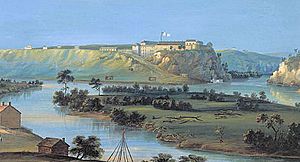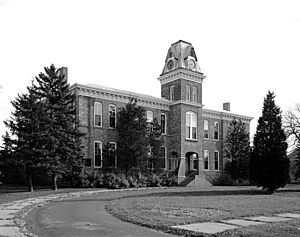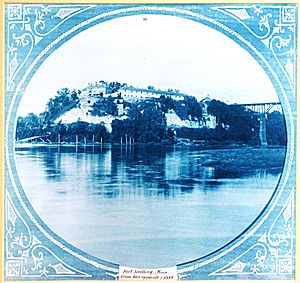Fort Snelling facts for kids
|
Fort Snelling
|
|

Fort Snelling's round tower
|
|
| Location | Fort Snelling Unorganized Territory, Minnesota |
|---|---|
| Nearest city | Bordering Minneapolis, St. Paul, Mendota and Mendota Heights. |
| Built | 1819 |
| Architect | Colonel Josiah Snelling |
| Website | Historic Fort Snelling |
| NRHP reference No. | 66000401 |
Quick facts for kids Significant dates |
|
| Added to NRHP | 15 October 1966 |
| Designated NHL | 19 December 1960 |
Fort Snelling is a very old military fort in Minnesota, USA. It sits high up on cliffs where the Minnesota River and Mississippi River meet. The fort was first called Fort Saint Anthony. It was renamed Fort Snelling in 1825 when it was finished.
Before the American Civil War, some soldiers at the fort brought enslaved people with them. Dred Scott and Harriet Robinson Scott, an enslaved couple, lived at the fort in the 1830s. They later sued for their freedom. They argued that living in a "free territory" should make them free. This led to a very important court case called Dred Scott v. Sandford. Slavery ended at the fort before Minnesota became a state in 1858.
The fort was a main base for U.S. forces during the Dakota War of 1862. It was also a place where Dakota and Ho-chunk families, who were not fighting, waited. They were forced to leave Minnesota by riverboat after the war. Fort Snelling was used to train soldiers during the Civil War, the Spanish–American War, and both World Wars. It was closed down in 1946.
The lower part of the fort was fixed up in 1965. Only the round and hexagonal towers were left from the original fort. Many important buildings in the upper part of the fort are still there today. Some of them still need repairs.
The historic fort is in a special area called Fort Snelling unorganized territory. This area is in Hennepin County. It is next to Ramsey and Dakota counties.
Today, different government groups own parts of the old fort. The Minnesota Historical Society manages the Historic Fort Snelling site. The Minnesota Department of Natural Resources runs Fort Snelling State Park. This park is at the bottom of the cliff. Fort Snelling used to cover the land where the park is now. The fort is also part of the Mississippi National River and Recreation Area. This is a unit of the National Park Service.
Contents
What is the History of Fort Snelling?
How Fort Snelling Began
In 1805, Lieutenant Zebulon Pike bought a large area of land for the United States. This land was called Pike's Purchase. It was about 100,000 acres. Many people started settling in the area in the late 1810s.
After the War of 1812, the U.S. Army built a line of forts. These forts stretched from Lake Michigan to the Missouri River. They were built to protect the northwestern lands from British forces from Canada. The Army started Fort Saint Anthony in 1819.
Colonel Josiah Snelling was in charge of the 5th Infantry Regiment (United States). His soldiers built the first Fort Saint Anthony from 1820 to 1824. While building, most soldiers lived at Camp Coldwater. This camp provided drinking water for the fort for many years. In 1820, the fort's doctor started keeping weather records. This is one of the longest continuous weather records in the country. In 1825, the Army renamed the fort Fort Snelling to honor Colonel Snelling.
Fort Snelling as a Frontier Outpost
Soldiers at Fort Snelling worked to control who used the rivers for trade. They also tried to keep American Indian lands free from white settlers. This was until treaties allowed settlement. They also worked to keep law and order and protect travelers and traders. At Fort Snelling, the soldiers also tried to keep peace among the Dakota people.
Colonel Snelling left Fort Snelling in September 1827. He died in 1828 from an illness.
John Marsh came to the fort in the early 1820s. He started the first school for officers' children at the fort. He also became friends with the local Sioux tribe. He even created a dictionary for the Sioux language. Marsh had studied medicine at Harvard. He continued to study medicine with the fort's doctor, Dr. Purcell.
In 1830, John Taylor Wood was born at Fort Snelling. He later became a lieutenant in the Confederate navy. He served on the ship Merrimack during the Battle of Hampton Roads.
John Emerson bought the enslaved man Dred Scott in St. Louis, Missouri. Emerson brought Dred and his wife Harriet Scott to Fort Snelling in the 1830s. They lived and worked there. The Missouri Compromise made slavery illegal in Minnesota Territory. Emerson later took the Scotts back to Missouri, which was a slave state. The Scotts sued for their freedom. They argued they should be free because they had lived in a free territory. A court rule that usually said "once free, always free" was overturned. The United States Supreme Court case of Dred Scott v. Sandford (1857) decided that the Missouri Compromise was unconstitutional. It also said that African Americans did not have rights under the Constitution.
Seth Eastman was an Army officer and artist. He spent two periods of time at Fort Snelling. His second stay was long, in the 1840s, when he commanded the fort. He created many paintings and drawings of the Dakota and other Native American peoples. He helped record their customs and lives. Congress asked him to illustrate a six-volume study called Indian Tribes of the United States. This study was written by Henry Rowe Schoolcraft and published from 1851-1857. It included hundreds of Eastman's artworks.
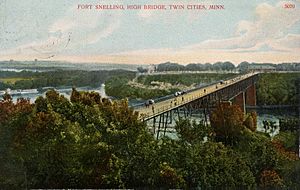
As the cities of Minneapolis and Saint Paul, Minnesota grew, there was less need for a military fort so far out on the frontier. The Army sold Fort Snelling to Franklin Steele in 1858 for $90,000. This deal also included 8,000 acres of land. This land was later added to south Minneapolis.
Fort Snelling During and After the Civil War
During the American Civil War, Franklin Steele rented Fort Snelling back to the War Department. It was used as a place to sign up new soldiers. More than 24,000 soldiers from Minnesota were trained here. During the Dakota War of 1862, the Army used the fort as a base. They held hundreds of Dakota women, children, and elders as captives. They were held on the river flats below the fort through the winter of 1862–63. Many people died there. After the war, Steele rented the land around Fort Snelling to settlers. Minneapolis then began to grow into the areas around the fort.
The United States Army kept soldiers at Fort Snelling. The fort sent soldiers to protect settlers on the frontier. These soldiers went west towards the Rocky Mountains. Soldiers from Fort Snelling fought in the American Indian Wars and the Spanish–American War of 1898.
During World War II, Fort Snelling was chosen for the Military Intelligence Service Language School. This school taught the Japanese language to Army personnel. Many buildings were built for housing and teaching. The school trained 300,000 soldiers. After the war, in June 1946, the school moved to Monterey, California.
Fort Snelling's Second Decommissioning
The War Department closed Fort Snelling on October 14, 1946. Different government groups took over parts of the old fort's land. Most of the buildings became run down. In 1960, it was named a National Historic Landmark. This was because it was the first major military post in the area. It was also important for the history of the United States Army.
Fort Snelling continued to be the main office for the United States Army Reserve 205th Infantry Brigade. This group included soldiers and support units from the Upper Midwest. The Defense Department closed this unit in 1994. Over the years, many soldiers from Minnesota have been buried at Fort Snelling National Cemetery. Some military buildings still operate around the old Fort Snelling.
The Minnesota Historical Society has turned the original walled fort area into an educational site. It has been rebuilt to look like it did originally. During spring, summer, and early fall, people in costumes show what life was like at the early fort. While the original fort is saved, many other buildings that were used for a short time became very run down. In May 2006, the National Trust for Historic Preservation added the Upper Post of Fort Snelling to its list of "America's Most Endangered Places." Some restoration work continues at historic Fort Snelling.
The United States Navy named an amphibious warfare ship, the USS Fort Snelling (LSD-30), to honor the fort.
Where is Fort Snelling Located?
The fort is in a special area called Fort Snelling Unorganized Territory. This is an area in Hennepin County that is not part of a city. It is just east of Richfield. It is also next to Minneapolis, Bloomington, Saint Paul (across the Mississippi River), and Mendota Heights (across the Minnesota River). The fort is at the eastern end of this territory. It is near where the Mississippi River and the Minnesota River meet.
Fort Snelling unorganized territory has many military and federal buildings. These include the historic Fort Snelling, its cemetery, and the Minneapolis Veterans Health Administration Medical Center. However, most of the land in this territory is taken up by the Minneapolis–St. Paul International Airport. This unorganized territory is about 17.2 square kilometers (6.7 square miles) in total. Most of it is land, and a small part is water.
What is the Population of Fort Snelling?
In 2000, 442 people lived in the unorganized territory. The population density was about 26.8 people per square kilometer (69.5 per square mile). Most of the people were White (94.57%). A smaller number were Black or African American (3.62%) and Native American (1.36%). About 0.45% of the population was Hispanic or Latino.
The population had different age groups. About 4.5% were 25 to 44 years old. About 33.0% were 45 to 64 years old. The largest group, 62.4%, were 65 years old or older. The average age was 69 years.
Airport and Businesses Near Fort Snelling

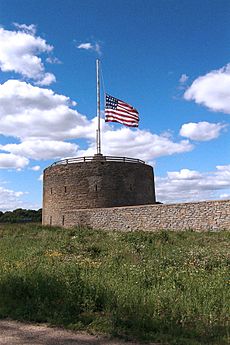
Delta Air Lines Building C is located on the property of Minneapolis–St. Paul International Airport. It is also in the Fort Snelling area. Delta uses this building for its northern and regional operations.
In 2009, when Northwest Airlines and Delta Airlines joined together, Delta moved all employees from Northwest's old headquarters. All employees who stayed in Minneapolis moved to Building C, which was updated. Other companies like Compass Airlines and Regional Elite Airline Services also have offices in this building.
Before it closed, Republic Airlines (1979–1986) had its main office in Building C. At different times, both Mesaba Airlines and MAIR Holdings had their main offices in the Fort Snelling Unorganized Territory.
Images for kids
-
The Wokiksuye K'a Woyuonihan memorial site at Fort Snelling, with a pipestone encased in the center, surrounded by bundles of the four sacred medicines: sage, cedar, tobacco, and sweetgrass.
See also
 In Spanish: Fort Snelling para niños
In Spanish: Fort Snelling para niños



